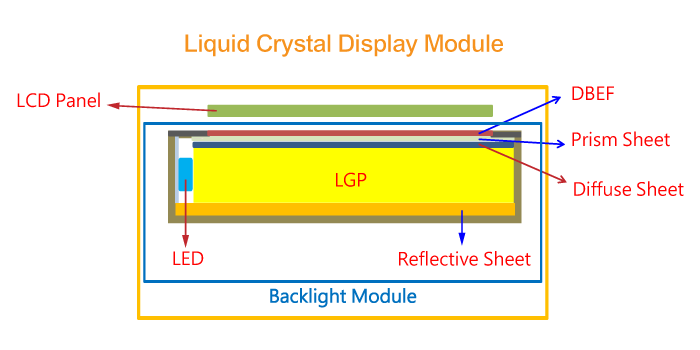What is backlight module?

Backlight Module, the light source of TFT-LCD, is constructed by optical films, Işık Kılavuzu Plaka, LED light bar, back-cover and plastic case. Because the liquid crystal molecule only function as the penetration level that doesn’t illuminate spontaneously, it is necessary to add a backlight module to distribute the light that make us to see the beautiful scene on the screen. Thus, backlight module is the key part for TFT-LCD. Not only as the light source of TFT-LCD, backlight module is also critical to brightness, uniformity, formation, and view angel of LCD.
Liquid Crystal Displays (LCDs)
The most widespread application of backlight modules is in liquid crystal displays (LCDs). Since LCD panels do not emit light on their own, a backlight is required to illuminate the LCD panel, enabling images and text to be displayed. Backlight modules ensure the display quality of LCDs by providing uniform backlighting.
Mobile Devices
Backlight modules are particularly prominent in mobile devices such as smartphones, tablets, and laptops. These devices typically use LED backlight modules because they are more energy-efficient, have a longer lifespan, and allow for easier control of backlight brightness and color.
Televisions
As LCD modules continue to evolve toward brighter, lighter, and thinner designs, edge-lit CCFL backlighting has become the mainstream trend in backlighting development. Large-screen television backlight modules also adopt an edge-lit structure.
Automotive Dashboards
In automotive dashboards, backlight modules are used to illuminate the display panel, enabling drivers to clearly view instrument information under various lighting conditions. These backlights typically require high brightness, long lifespan, and excellent stability.
Industrial Displays
In industrial environments, backlight modules are used in various displays, such as human-machine interfaces (HMIs) and monitoring systems. These displays must operate in harsh conditions, so backlight modules must offer high brightness, long lifespan, and excellent stability.
Medical Equipment
In medical equipment, backlight modules are used to illuminate display panels, enabling doctors and nurses to clearly view displayed information under various lighting conditions. These backlight modules typically require high brightness, long lifespan, and excellent stability.
Advertising and Display
In the advertising and display industry, backlight modules are used to illuminate billboards and display panels. These backlights typically require high brightness and good uniformity to ensure that advertising and display content is clearly visible.
In summary, backlight modules have widespread applications across various industries, and their performance directly impacts the visual quality of LCD modules. As LCD display technology continues to advance, backlight modules are also evolving to meet the demands of diverse applications.
Backlight modules are one of the key components of LCD panels. Their function is to provide sufficient brightness and uniformly distributed light sources to enable normal image display. This is because LCD screens themselves do not emit light. With the continuous development of LCD technology, the application areas of LCD displays, especially color LCD displays, are also expanding. Driven by the LCD display market, the backlight industry is thriving. LCDs are non-emissive display devices that require a backlight to achieve their display functionality.
The performance of the backlight not only directly affects the display quality of the LCD but also plays a crucial role in the backlight module (BLM), which is one of the key components of an LCD panel, accounting for approximately 20% to 35% of the total material cost of the panel. The three main components of the backlight module are the light source, the light guide plate, and the optical film, which together account for 72% of the total cost of the backlight module. The light source refers to the lamp tube. The light guide plate serves to diffuse the linear light source into a diffuse light source. The primary function of the optical film is to concentrate light and enhance brightness. Among these components, the optical film is the most expensive, accounting for 44% of the backlight module’s cost, followed by the light guide plate at 16%, the lamp tube at 12%, and other components such as the lamp cover and outer frame at 28%. Additionally, power consumption accounts for 75% of the module’s energy usage, making it a critically important component within the LCD module. High-resolution, large-sized LCDs require high-performance backlight technology to complement them. Therefore, as the LCD industry strives to explore new application areas, the high-performance evolution of backlight technology (such as high brightness, low cost, low power consumption, and lightweight design) plays a crucial supporting role behind the scenes.
 Özelleştirilmiş Arka Işık Çözümleri & Optik sayfalar tedarikçi – Rnoda Tech
Özelleştirilmiş Arka Işık Çözümleri & Optik sayfalar tedarikçi – Rnoda Tech

